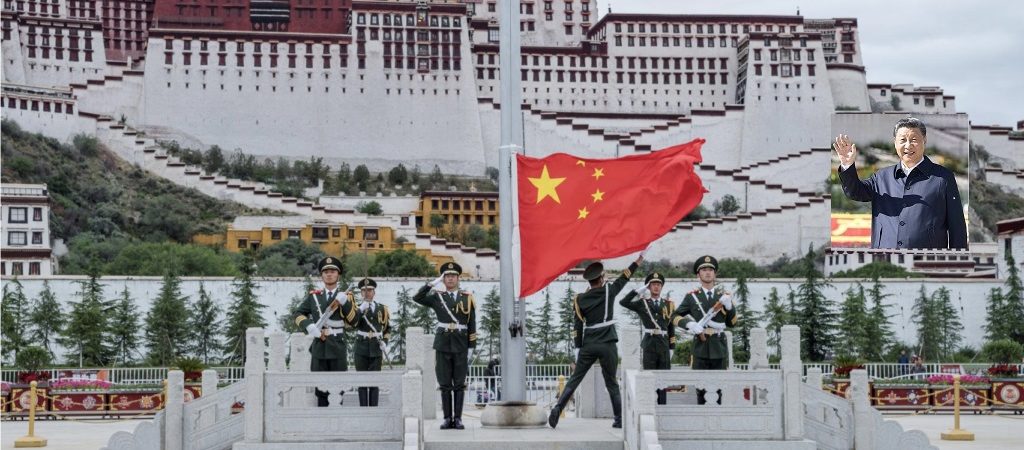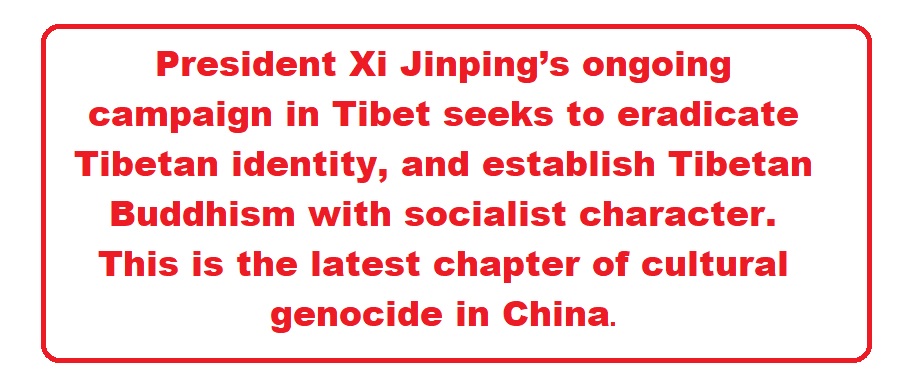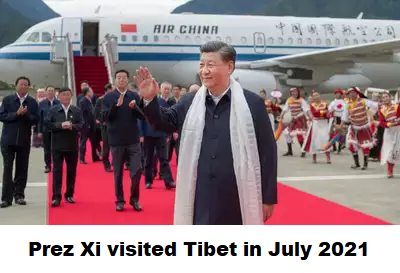
Cultural Genocide in Tibet for A Harmonious China


The Chinese Communist Party (CCP) is in an overdrive to implement President Xi Jinping’s philosophy of ‘Tibetan Buddhism with Socialist Character”. And decreed that all Tibetan Communist cadres and Tibetans holding government jobs, especially in teaching, must stop participation in any form of Tibetan religious practices.
The banned activities and practices range from visits to Tibetan temple, ‘Kora’ (circumambulation) at a temple or a Stupa, and holding rosary or ‘Mani’ (Tibetan prayer wheel). Also not allowed is conducting prayers at the family altar. Even using digital prayer beads or listening to prayers on the mobile phone is strictly banned.
Tibetan officials have been instructed to remove the traditional family altar from their homes which is an integral part of Tibetan life. Yet another order bans them from participating in the last prayer rituals in the event of death of a family member or a close relative.
The CCP has appointed special agents in each office and community to report on Tibetan cadres and officials who break these laws. Any person found engaged in such activities may face sacking from their government jobs, denial of all special entitlements, and even arrest, according to reports coming out of Tsolho Tibetan Autonomous Prefecture of Qinghai province, known as ‘Amdo’ before Chinese occupation of Tibet in 1951.

During his unannounced visit to Tibet in July, President Xi instructed the Communist cadres and officials to promote Tibetan Buddhism with socialist character. And exhorted common Tibetan people to “follow the (Communist) Party for the rejuvenation of the Chinese nation”. Since then, rules about the conduct of cadres and officials have become stricter.
International Campaign for Tibet, a Washington based advocacy group, has put spotlight on a document on the code of conduct for Tibetan officials and Party members. Titled “Code of Conduct for Communist Party members in the Tibetan Autonomous Region for Not Believing in Religion,” the document lists a host of dos -and-don’ts for the officials.
Sonam Tsering, General Secretary of Tibetan Youth Congress, (TYC), is amused at these restrictions on the Tibetan communist cadres and officials. TYC is the largest socio-political organization among the Tibetan Diaspora.
“The fact that the CCP has to issue a code of conduct to stop the Communist cadres and Tibetan officials from practicing religion proves that they have failed to wipe out the Tibetan identity and the influence of Buddhism from their hearts despite seven decades of colonial rule over Tibet”, Sonam Tsering said, adding that this in itself is enough to prove that “Tibetan people have refused to accept the rule and dominance of China”.
During a rarely allowed conducted media tour early this year, a dozen foreign journalists were surprised to see huge portraits of top Chinese Communist leaders, especially of President Xi Jinping in monasteries, temples and schools. At Jokhang, the national temple of Tibet in Lhasa, a reporter asked a monk, “who is your spiritual Guru?”. Prompt came the reply: “President Xi Jinping is my spiritual Guru.”
In their overenthusiasm to implement President Xi’s idea of ‘Tibetan Buddhism with Socialist Character’, the Chinese authorities in Lhasa have banned teaching of Tibetan language in the schools. Already China has stopped Tibetan medium at school levels and made Mandarin as the only language of instruction. Now the latest diktat bans teaching of basic Tibetan in private Tibetan schools, which are run with public efforts during non-school hours or during winter holidays.
The campaign for “Tibetan Buddhism with Socialist Character” is run religiously by the CPP bosses in the traditional Tibetan areas which are out of Tibet Autonomous Region (TAR). It may be recalled that China reorganized Tibet in 1965, and designated its ‘U-tsang’ province as the ‘TAR’. Two other Tibetan provinces, namely ‘Kham’ and ‘Amdo’ were delinked from Tibet and their areas were distributed among four adjoining Chinese provinces of Yunnan, Sichuan, Qinghai and Ganzu. Some areas with dense Tibetan populations in these Chinese provinces were further designated as Tibetan Autonomous Prefectures. The current campaign is focused more on these Prefectures.

The 11th People’s Congress of TAR in 2020 adopted new regulations for Tibet which oblige the controlling authorities of Tibet to establish “model areas for national unity and progress” in TAR. These regulations give special powers to the Chinese bosses in Tibet to impose a China-centric way of life on Tibetan people. And mark an extension of Chairman Mao’s idea of bringing unity through uniformity in China.
Mao’s ‘unity’ concept has already been implemented effectively among many other occupied regions and societies which are termed as ‘minority nationalities’ in the Chinese communist lingo. As a result, the areas belonging originally to the likes of the Manchu, Hui, Miao, Naxi, Kirgiz, Yi, Zhuang, Bouyei, Dong, Yao, Bai, and Di nationalities have been converted into regions with Han dominance and Han characteristics.
Other tricks adopted ranged from bulk transportation of local communities to distant places of China to bulk Han migration to such areas in the name of developing new cities and infrastructure projects. Forced (encouraged?} inter-racial marriages and birth control through forced abortions are amongst the other routes adopted to establish unity through uniformity.
No surprise today’s China can boast of a ‘reasonably harmonious’ country where Hans comprise over 82 percent of the population and the remaining 55 ‘sisters’ account for less than 8 percent.
If the ongoing processes of eradicating Islam from former ‘East Turkistan’ (now ‘Xinjiang’) and erasing the Buddhist personality of Tibet and South Mongolia (Inner Mongolia) succeed, it will be President Xi greatest contribution to cultural genocide to herald a truly “harmonious China,” to the dismay minorities in the country. (POREG)
-
CHINA DIGEST
-
 ChinaChina Digest
China’s PMI falls for 3rd month highlighting challenges world’s second biggest economy faces
ChinaChina Digest
China’s PMI falls for 3rd month highlighting challenges world’s second biggest economy faces
-
 ChinaChina Digest
Xi urges Chinese envoys to create ‘diplomatic iron army’
ChinaChina Digest
Xi urges Chinese envoys to create ‘diplomatic iron army’
-
 ChinaChina Digest
What China’s new defense minister tells us about Xi’s military purge
ChinaChina Digest
What China’s new defense minister tells us about Xi’s military purge
-
 ChinaChina Digest
China removes nine PLA generals from top legislature in sign of wider purge
ChinaChina Digest
China removes nine PLA generals from top legislature in sign of wider purge
-
-
SOUTH ASIAN DIGEST
-
 South Asian Digest
Kataragama Kapuwa’s arrest sparks debate of divine offerings in Sri Lanka
South Asian Digest
Kataragama Kapuwa’s arrest sparks debate of divine offerings in Sri Lanka
-
 South Asian Digest
Nepal: Prime Minister Dahal reassures chief ministers on police adjustment, civil service law
South Asian Digest
Nepal: Prime Minister Dahal reassures chief ministers on police adjustment, civil service law
-
 South Asian Digest
Akhund’s visit to Islamabad may ease tensions on TTP issue
South Asian Digest
Akhund’s visit to Islamabad may ease tensions on TTP issue
-
 South Asian Digest
Pakistan: PTI top tier jolted by rejections ahead of polls
South Asian Digest
Pakistan: PTI top tier jolted by rejections ahead of polls
-






Comments